
|
Hugh McDonald
Steel Rolling Mill Plans Including Operating Instructions Distributed by anvilfire.com
Perfect Binding
|
|
Review Part I - by Jock Dempsey
Part II - Examples
NEW CD-ROM Version!
The McDonald Mill is not just a set of plans but a FANTASTIC invention! It is NOT just another rolling mill. This is a revolutionary NEW machine that in any other era would have been patented and made the inventor huge profits. Hugh McDonald has done what thousands of smiths (including myself) have dreamed of and schemed over and never came up with the solution. The Solution:
Its SO simple! But the best ideas are simple, and MANY others have worked on this problem and not come up with this brilliant but simple solution. All conventional roller mills have fixed roller spacing or spacing adjusted by screws. In operation the hot metal is fed in one side and out the other. This required TWO operators and for efficiency a "three high roll" where the second man could feed the work back to the first. The only one man rolls were known as "D" rolls because they had a flat on the roller. In these the operator fed the hot steel between the rolls when the flats were aligned and made a gap. D-rolls have a work length limited by the diameter of the rolls and the circular circumference. D-rolls were typically large and expensive to build. The McDonald Mill has changed all that. By taking a chance that a small mill would work, and putting considerable research time into it, Hugh McDonald has proved it works. And he has provided us with detailed plans about how to build this wonderful machine! Not only is this a GREAT machine, it does the same job as "small" hydraulic forging presses do but with ONE TENTH the horsepower! Where a small hydraulic press for forging laminated steel takes 10 to 15 horsepower and probably a 3 phase 220 volt service,
using only 1 to 1-1/2 horsepower! This means it can be run on 120VAC on a long extension cord. Matter of fact it is possible to build one of these little machines that works on 3/4 horsepower! |
|
- Jim Steele, WA, Australia | |
|
In locations where a power hammer is too noisy or the vibration would bring complaints from the neighbors this machine is perfect! It is almost silent, requires no special foundations and runs on single phase power. It may not replace a power hammer in all respects but it can be used where a power hammer cannot. The Plans include high quality assembly and detailed drawings with dimensions. The plans have flexibility for the use of metric or English parts. The drawings are professionally made and easy to read. There are notes on making each part and the reasons for the way the parts are made. But the most important part of the plans is Hugh's insights into how the machine works and what doesn't work. He also includes a page on specifics about how to use the mill and problems that arise in rolling Damascus. -- Click the drawing image below for an enlargement. |
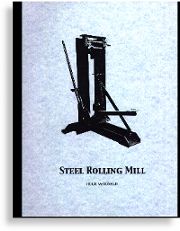
|
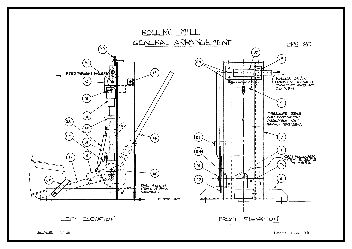
|
|
Hugh points out that this machine does not replace a power hammer. Nor does it completely replace a hydraulic press. However, the things it DOES do it does very well. Hugh uses the mill to roll out tong reigns and to make the blade on letter openers. The machine has all kinds of possibilities besides welding and rolling laminated steel. The Rumor: There has been a rumor going around that this machine is a figment of someone's imagination and that you can not roll steel with two inch rollers. I too would find it hard to believe, except Hugh produced a short amature video that has been making the rounds and it clearly shows that IT DOES WORK! |
|
| |

|
"Hi, I'm Hugh McDonald from Gooseberry Hill near Perth in Western Australia which is all that you need to know about me."
"The machine we are interested in here is a Damascus Roller. I have a billet in the gas forge that is five layers of two different sorts of carbon steel. . . . and will endeavor to weld this and roll it out as we go." |
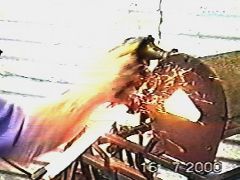
|
"First we have to brush the flux off."
This is an important step as the liquid flux acts like a lubricant and the rollers will slip. |

| The steel billet is inserted into the rolls, the rolls clamped onto the billet and it then feeds toward Hugh and out of the rolls. |
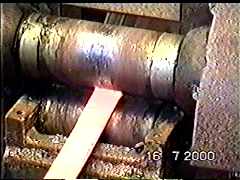
|
Hugh quickly rolls the steel out and makes about three passes in ONE heat.
The machine makes virtually no noise except a little clicking from the chain drive. The roar of the gas forge is much louder. |

|
"The billet has now been rolled out to about 4 millimeters thick."
Approximately 3/16 inch thick |
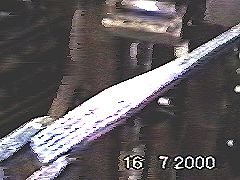
|
"You can see the unwelded piece on the end."
"The next step would be to reverse the piece in the forge and weld the other end, and then cut it, fold it and continue with the Damascus process." |
|
This is about half the video.
It goes on to show the rolling of piece of 22mm round spring steel bar in 8 passes and one heat to 5mm thick and still the original width.
Then Hugh demonstrates how to roll a taper and shows off his original mild steel rollers.
Yes, MILD steel rollers work fine.
Streaming Rolling Mill Video on AnvilCAM-II
| |

|
The First Commercial Model of the McDonald Mill called The BLU Crusher was manufactured under license. It is no longer in production. This machine is a modified version of the McDonald machine. It uses a worm gear drive and a bottle jack (not recommended) has replaced the McDonald adjustment mechanism. |
|
Review Part II - Examples
Sold in the anvilfire.com store!
Hugh McDonald
Price: 25.00$ US plus S&H | ||
|
